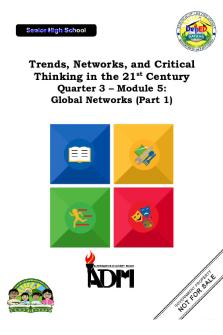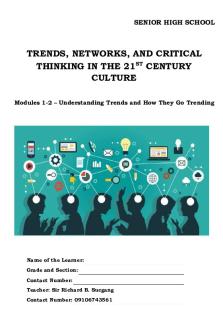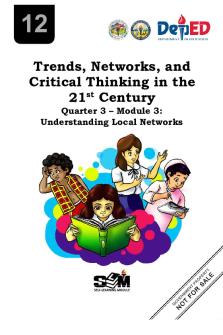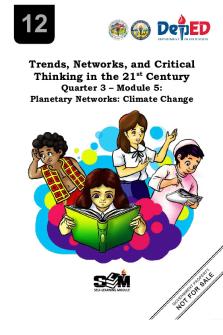Trends Networks Module 4 PDF

| Title | Trends Networks Module 4 |
|---|---|
| Course | Senior High School |
| Institution | The National Teachers College |
| Pages | 33 |
| File Size | 1.7 MB |
| File Type | |
| Total Downloads | 351 |
| Total Views | 571 |
Summary
iiTrends, Networks, and Critical Thinking in the 21st Century - 12 Alternative Delivery Mode Module 4: Planetary Networks: Climate Change First Edition, 2019Republic Act 8293, section 176 states that: No copyright shall subsist in any work of the Government of the Philippines. However, prior approva...
Description
Trends, Networks, and Critical Thinking in the 21st Century - 12 Alternative Delivery Mode Module 4: Planetary Networks: Climate Change First Edition, 2019 Republic Act 8293, section 176 states that: No copyright shall subsist in any work of the Government of the Philippines. However, prior approval of the government agency or office wherein the work is created shall be necessary for exploitation of such work for profit. Such agency or office may, among other things, impose as a condition the payment of royalties. Borrowed materials (i.e., stories, songs, poems, pictures, photos, brand names, trademarks, etc.) included in this book are owned by their respective copyright holders. Every effort has been exerted to locate and seek permission to use these materials from their respective copyright owners. The publisher and authors do not represent nor claim ownership over them.
Development Team of the Module: Authors: Editor: Illustrator:
Roy H. Lumban Arrianne Christelle J. Apostol Vianna Dominique B. Gaston
Management Team: Chairperson: Co-Chairpersons:
Members:
Dr. Arturo B. Bayocot, CESO III Regional Director Dr. Victor G. De Gracia Jr., CESO V Asst. Regional Director Mala Epra B. Magnaong CES, CLMD Dr. Bienvenido U. Tagolimot, Jr. Regional ADM Coordinator Ray Butch M. Mahinay EPS-Designate- AP
Printed in the Philippines by: Department of Education – Regional Office 10 Office Address: Zone 1, Upper Balulang Cagayan de Oro City 9000 Telefax: (088) 880-7071, (088) 880-7072 E-mail Address: [email protected]
12 Trends, Networking, and Critical Thinking in the 21st Century QUARTER 2 -
ODULE 4
PLANETARY NETWORKS: CLIMATE CHANGE
This instructional material was collaboratively developed and reviewed by educators from public and private schools, colleges, and/or universities. We encourage teachers and other education stakeholders to email their feedback, comments, and recommendations to the Department of Education at [email protected]. We value your feedback and recommendations.
Department of Education • Republic of the Philippines iii
Table of Contents Cover Page Copyright Page Module Title Writers’ Profile Table of Contents
i ii iii iv v
Module 2 – Planetary Networks: Climate Change What I Need to Know What Should I Expect Things to Remember To Get Through What I Know
1 2 3 4
CONTENTS Lesson 1: Activities that Exemplify care for the Environment
What I Know What’s In What’s New What is it What’s More What have I learn
5 5 5 6 7 7
Lesson 2: Effects of Consumption and Production Patterns
What I Know What’s In What’s New What is it What’s More What have I learn What Can I do more
9 9 9 10 10 11 12
Lesson 3: Effects of Climate Change
What I Know What’s In What’s New What is it What’s More What have I learn What Can I do more
13 13 13 14 14 15 15 v
Lesson 4: Steps to Address the Problems of Climate Change
What I Know What’s In What’s New What is it What’s More What have I learn What Can I do more Assessment
17 17 18 18 19 20 20 21
CONTENTS Module 1: Democratic Interventions What I Need to Know What Should I Expect Things to Remember To Get Through What I know
23 23 24 25
Lesson 1: Democratic Practices
What I Know What’s In What’s New What is it What’s More What have I learn What Can I do
28 28 28 29 30 31 31
Lesson 2: Benefits and Importance of Democratic Participation
What I Know What’s In What’s New What is it What’s More What have I learn What Can I do
33 33 33 34 34 35 35
vi
Lesson 3: Participatory from Representative Democracy.
What I Know What’s In What’s New What is it What’s More What have I learn What Can I do Assessment Reference
36 36 36 37 37 38 38 40 42
vii
Module 4
PLANETARY NETWORKS: CLIMATE CHANGE
WHAT I NEED TO KNOW
Is climate change real? Are you aware of what is happening in our country today in relation to climate change? These questions might help you to uncover the underlying situation by studying this module. Specifically, It will help you to bring out social awareness and foster social responsibility on what you can do to lessen the effects of climate change. This module brings you to the real scenario of the condition brought about by climate change. It help you understand the consequences of one’s action on how consumption and production patterns affects climate change. It will further discusses the effects and the steps to address climate change.
WHAT SHOULD I EXPECT After studying this module, you will be able to 1. Identify the list of activities that exemplify care for the environment. 2. Explain how important that we show care for the environment 3. Discuss the effects of consumption and production patterns that contribute to the problem of climate change. 4. Analyze in what ways these products being used daily affect the environment. 5. Identify the effects of climate change. 6. Explain and illustrate personal contributions that can actually solve the problem of climate change 7. Discuss the steps to address the problems of climate change 8. Write a resolution on how you can personally contribute towards solving the problem of climate change 9. Explain the consequences of one’s action that affect the lives of others and the environment.
1
THINGS TO REMEMBER TO GET THROUGH
To attain the goals of this module, please do the following; 1. 2. 3. 4. 5. 6. 7. 8. 9.
Take your time to read and understand the concepts in this module. Follow the instruction carefully in every given task. Answers all the assessment tests industriously. Work on the activities in this module and in every performance task given. Take the Post-Test after you are done with all the lessons and activities in the module Familiarize yourselves with the given terms. Meet with your teacher. Ask him/her about any difficulty or confusion you have encountered in this module. Finally, prepare and gather all your outputs and submit them to your teacher. Please write all your answers of the tests, activities, exercises, and others on your separate activity notebook.
GOOD LUCK AS YOU BEGIN THIS MODULE!
2
What I Know
As an initial activity, you will be assess on your prior knowledge. This is to find out what are the things you need to learn about the subject matter. Multiple Choice: Write the letter of the correct answer before each number. _______1. What causes the greenhouse effect? a. Greenhouse gases in the lower atmosphere absorbing solar radiation b. Greenhouse gases in the lower atmosphere absorbing radiation from the earth's surface, and preventing much of it escaping into space c. Too much heat in the atmosphere d. Too much sunshine reaching Earth ________2. Which of the following activities contribute the most to carbon emissions globally? a. Energy Supply c. Agriculture b. Transport d. Forestry ________3. What is NOT believed to be a cause global warming? a. Increase in greenhouse gases b. Burning fossil fuels c. Increase in human populations d. None of the above ________4. Which particular effect of Global warming that has affected many parts of earth? a. Cooler temperatures c. Season changes b. Melting ice d. None of the above ________5. What global issue that refers to the rise in average surface temperatures on earth due to the burning of fossil fuels? a. Climate change c. Ultraviolet rays b. El Niño d. Heat wave ________6. Which of the following statements best describe the solutions to climate change? a. Stop down the cutting of tress b. Less use of the fossil fuels c. More consumption on energy d. Focused on the renewal energy
3
________7. Which of these statement is the true cause of the greenhouse effect? a. Excess of nitrogen in the atmosphere b. Excess of carbon dioxide in the atmosphere c. Heat from the sun that reaches the surface of the earth d. All of the above ________8. What can you do to prevent climate change in your level? a. Drive your car less and use public transport b. Turn off the lights when not in use c. Recycle the materials d. All of the above ________9. Which of the following activities are the causes of climate change, except? a. Rise of the sea levels c. Deforestation b. Burning of fossil fuels d. Food consumption _______10. Which of the following statements is true about climate change? a. Global sea level are rising. b. Get rid from fuel companies is the best solutions for climate change. c. Majority of the scientists agree that climate change is caused by natural phenomenon. d. Humans are insignificant to affect global climate.
True or False. Analyze each statement. Write T If the statement is true but if the statement is false write F. Write your answer on the space provided. _______11. Using plastic cups help the environment as it helps for refilling water water or juices. ________12. Use regular bulbs instead of energy-efficient light bulbs. ________13. Turning off lights, TV, and other appliances when not in use help conserve our energy. ________14. Taking public transportation is better than walking, or riding a bike as Best options that help our the environment. ________15. Using Cars or any public transportation are harmful to the environment. ________16. The food consumption and production have no significant impact on the environment. ________17. Renewable energy is one of the possible solutions for climate change. ________18. Agriculture activities contribute the most to carbon emissions globally. ________19. The increase of human populations is NOT believed to cause global Warming ________20. Fossil fuels are natural fuel such as coal or gas, formed in the geological past from the remains of living organisms.
4
Lesson
ACTIVITIES THAT EXEMPLIFY CARE FOR THE ENVIRONMENT
1
(HUMSS_MCT12Ih-i-1)
This lesson will highlight the simple ways list of activities on how we are going to take care of our environment. There are no other creation who will take care for our environment except for us human beings. Our personal actions will contribute in taking care of our environment. A simple step will make big difference.
What I Need to Know end of the lesson, the learners are expected to: 1. Identify the list of activities that exemplify care for the environment. 2. Explain how important that we show care for the environment.
What’s In
Last meeting, we have discussed about what is trend, how to spot a trend, the characteristics of a trend, how trend differ from a fad, the elements of trend, emerging patterns of trend, part of a whole and discovering the relationships between cause and consequence. This time, we will identify the list of activities that exemplify care for the environment and how important that we show care for the environment.
What’s New
Direction: List activities that exemplify the ways on how we take good care for the environment.
Activities that exemplify the ways on how we take good care for the environment.
5
What is it
Paskill (2018) suggested eight (8) simple ways to help care our environment. In every little thing you make a difference. 1. Use Reusable luggage If you're attending to mall for searching like grocery, food, and garments you would like to apply the plastic luggage. Mistreatment reusable luggage helps the atmosphere. Plastic grocery-type luggage that get thrown out find yourself in landfills and it takes years to decompose. 2. Print as very little as Necessary Using such a lot paper is damaging to the atmosphere. If possible recycle the utilization writing paper for printing. If not, print on either side of the page to scale back the number of paper used. 3. Recycle Instead of throwing recyclables within the trash along with your non-recyclables, recycle the materials of fine use. create a degree to require an additional step to separate reclaimable materials like cans, bottles, plastic and papers. 4. Use a Reusable nutrient Containers In most school, fruit juices is served mistreatment plastic cups, rather than shopping for this cup of drinks on an individual basis, deliberate to use a reusable bottle. Not solely can this facilitate the atmosphere it saves your money for several of the campuses that provide water fountains designed for drinking still as for replacement reusable water bottles. 5. Don’t Throw Your Notes Away Keeping your notes can facilitate the scholars by having the ability to scan what they're learning within the words of another student. If you can’t notice anyone to convey the notes to, at the terribly least, recycle the paper you used. 6. Save Electricity! Use energy-efficient light-weight bulbs rather than regular bulbs. They last longer, which can save your money. Make you turn off lights, the TV, and other appliances when you are not using them.
6
7. Save Water Water is wasted a lot frequently than we can see. Shut down the faucet as you're brushing your teeth. Don’t turn your shower on till you’re able to get in and wash your hair. Limit your water usage as you wash dishes. 8. Avoid Taking Cars or Carpool as possible Cars square measure harmful to the atmosphere. Taking public transportation, walking, or riding a motorcycle are better options that help the environment and your budget, as well as getting some exercise.
What’s More
True or False. Analyze each statement. Write T If the statement is true but if the statement is false write F. Write your answer on the space provided. ________1. It takes thousands of years for plastic grocery-type bags that get thrown in landfills. ________2. Using so much paper is detrimental to the environment. ________3. Using plastic cups help the environment as it helps for refilling water water or juices. ________4. Use regular bulbs instead of energy-efficient light bulbs. ________5. Turning off lights, TV, and other appliances when not in use help conserve our energy. ________6. Taking public transportation is better than walking, or riding a bike as Best options that help our environment. ________7. Using Cars or any public transportation are harmful to the environment. ________8. Recycling is better than reusing. ________9. The more people recycle, the less the people dispose their garbage ________10. Reduce, remove and recycle are the 3 R's of the environment.
What have I learn
Direction: In writing your reflection, you have to complete the sentence below. I learned that________________________________________________________ ___________________________________________________________________ ___________________________________________________________________ ___________________________________________________________________ 7
I realized that________________________________________________________ ___________________________________________________________________ ___________________________________________________________________ ___________________________________________________________________ If given a chance_____________________________________________________ ___________________________________________________________________ ___________________________________________________________________ ___________________________________________________________________
Now, Let’s Proceed to Lesson 2
8
Lesson
2
EFFECTS OF CONSUMPTION AND PRODUCTION PATTERNS (HUMSS_MCT12Ih-i-2)
This time, we will discuss the effects of consumption and production patterns that contribute to the problem of climate change and analyze in what ways these products being used daily affect the environment.
What I Need to Know At the end of the lesson, the learners are expected to: 1. Discuss the effects of consumption and production patterns that contribute to the problem of climate change. 2. Analyze in what ways these products being used daily affect the environment.
What’s In
In the previous lesson we learned about the simple ways list of activities on how we are going to take care of our environment. As a continuation we are going to discuss the effects of consumption and production patterns that contribute to the problem of climate change
What’s New
Instruction: Answer the questions from the column below. List down at least 10 products or In what ways do these products used daily affect goods that you use daily the environment? 1. 2. 3. 4. 5. 6. 7. 8. 9. 10. 9
What is it Climate change refers to the increase in average surface temperatures on Earth. An amazing scientific accord highlighted that global climate change is due primarily to the human use of fossil fuels, that releases dioxide and alternative greenhouse gases into the air. The gases trap heat inside the atmosphere, which may have a variety of effects on ecosystems. the results square measure the following; (a) rising ocean levels, (b) severe weather events, and (d) droughts that render landscapes additional vulnerable to wildfires. The food consumption and production have a major impact on the surroundings. The means we have a tendency to consume has each direct and indirect impacts on the surroundings. An example of this consumption is that the use of energy in our homes like television radio, computer, cars and public utility jeepney that emit harmful gasses and caused pollution and increased emissions of greenhouse gases that results in global climate change. Consumption conjointly vie an indirect impact towards our surroundings from the assembly, process and transportation of the products that we have a tendency to consume daily. Examples of this production of goods we consume are the can goods, soft drinks, processed foods, shampoo and many more.. In association, with consumption and production pattern within the Philippines, the state of surroundings in our country along with the emissions of greenhouse gasses, indicators on pollution and also the generation of material discovered that each one indicators show environmental degradations all told the domains being assessed (Sta. Romana, 2017).
What’s More
True or False. Analyze each statement. Write Pak If the statement is true but if the statement is false write Ganern. Write your answer on the space provided. ________1. Scientists believe that as the Earth continues to warm up, we are experiencing weather-related disasters. ________2. When we burn fossil fuels we release oxygen and carbon dioxide in the air. ________3. Most of the harmful gases are released either by automobiles or power plants. 10
________4. The food consumption and production have no significant impact on the environment. ________5. Renewable energy is one of the possible solutions for climate change. ________6. Volcanic eruptions are natural event that affect the climate change. ________7. Agriculture activities contribute the most to carbon emissions globally. ________8. The increase of human populations is NOT believed to cause global warming. ________9. Climate change is the rise in average surface temperatures on Earth, mostly due to the burning of fossil fuels. ________10. Fossil fuels are natural fuel such as coal or gas, formed in the geological past from the remains of living organisms.
What have I learn
Direction: In writing your reflection, you have to complete the sentence below. I learned that________________________________________________________ ___________________________________________________________________ ___________________________________________________________________ ___________________________________________________________________ I realized that__...
Similar Free PDFs

Trends Networks Module 4
- 33 Pages

Trends Q2 Module 3
- 32 Pages

Trends Q2 Module 2 - NONE
- 32 Pages

DLF-Trends-4 - jakdajk
- 35 Pages

Networks
- 28 Pages

Networks
- 2 Pages

MOD 4 - module 4
- 24 Pages
Popular Institutions
- Tinajero National High School - Annex
- Politeknik Caltex Riau
- Yokohama City University
- SGT University
- University of Al-Qadisiyah
- Divine Word College of Vigan
- Techniek College Rotterdam
- Universidade de Santiago
- Universiti Teknologi MARA Cawangan Johor Kampus Pasir Gudang
- Poltekkes Kemenkes Yogyakarta
- Baguio City National High School
- Colegio san marcos
- preparatoria uno
- Centro de Bachillerato Tecnológico Industrial y de Servicios No. 107
- Dalian Maritime University
- Quang Trung Secondary School
- Colegio Tecnológico en Informática
- Corporación Regional de Educación Superior
- Grupo CEDVA
- Dar Al Uloom University
- Centro de Estudios Preuniversitarios de la Universidad Nacional de Ingeniería
- 上智大学
- Aakash International School, Nuna Majara
- San Felipe Neri Catholic School
- Kang Chiao International School - New Taipei City
- Misamis Occidental National High School
- Institución Educativa Escuela Normal Juan Ladrilleros
- Kolehiyo ng Pantukan
- Batanes State College
- Instituto Continental
- Sekolah Menengah Kejuruan Kesehatan Kaltara (Tarakan)
- Colegio de La Inmaculada Concepcion - Cebu








